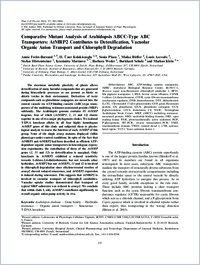Comparative mutant analysis of Arabidopsis ABCC-type ABC transporters: AtMRP2 contributes to detoxification, vacuolar organic anion transport and chlorophyll degradation
- Frelet-Barrand, Annie Zurich Basel Plant Science Center, University of Zurich, Switzerland - Laboratoire de Physiologie Cellulaire Végétale, Grenoble, France
- Kolukisaoglu, H. Üner University of Rostock, Institute of Biosciences, Germany - University of Rostock, Center for Life Science Automation, Germany.
- Plaza, Sonia University of Fribourg, Plant Biology, Switzerland
- Rüffer, Maika University of Rostock, Institute of Biosciences, Germany
- Azevedo, Louis Zurich Basel Plant Science Center, University of Zurich, Switzerland
- Hörtensteiner, Stefan Zurich Basel Plant Science Center, University of Zurich, Switzerland
- Marinova, Krasimira Zurich Basel Plant Science Center, University of Zurich, Switzerland - University Hospital Zurich, Clinical Pharmacology and Toxicology, Department of Internal Medicine, Switzerland.
- Weder, Barbara Zurich Basel Plant Science Center, University of Zurich, Switzerland
- Schulz, Burkhard Purdue University, Horticulture and Landscape Architecture, West Lafayette, IN, USA
- Klein, Markus Zurich Basel Plant Science Center, University of Zurich, Switzerland
-
2008
Published in:
- Plant and Cell Physiology. - 2008, vol. 49, no. 4, p. 557-569
Arabidopsis thaliana
gene family
herbicide resistance
organic anion transport
senescence
T-DNA knockout
English
The enormous metabolic plasticity of plants allows detoxification of many harmful compounds that are generated during biosynthetic processes or are present as biotic or abiotic toxins in their environment. Derivatives of toxic compounds such as glutathione conjugates are moved into the central vacuole via ATP-binding cassette (ABC)-type transporters of the multidrug resistance-associated protein (MRP) subfamily. The Arabidopsis genome contains 15 AtMRP isogenes, four of which (AtMRP1, 2, 11 and 12) cluster together in one of two major phylogenetic clades. We isolated T-DNA knockout alleles in all four highly homologous AtMRP genes of this clade and subjected them to physiological analysis to assess the function of each AtMRP of this group. None of the single atmrp mutants displayed visible phenotypes under control conditions. In spite of the fact that AtMRP1 and AtMRP2 had been described as efficient ATP-dependent organic anion transporters in heterologous expression experiments, the contribution of three of the AtMRP genes (1, 11 and 12) to detoxification is marginal. Only knockouts in AtMRP2 exhibited a reduced sensitivity towards 1-chloro-2,4-dinitrobenzene, but not towards other herbicides. AtMRP2 but not AtMRP1, 11 and 12 is involved in chlorophyll degradation since ethylene-treated rosettes of atmrp2 showed reduced senescence, and AtMRP2 expression is induced during senescence. This suggests that AtMRP2 is involved in vacuolar transport of chlorophyll catabolites. Vacuolar uptake studies demonstrated that transport of typical MRP substrates was reduced in atmrp2. We conclude that within clade I, only AtMRP2 contributes significantly to overall organic anion pump activity in vivo.
- Faculty
- Faculté des sciences et de médecine
- Department
- Département de Biologie
- Language
-
- English
- Classification
- Biological sciences
- License
-
License undefined
- Identifiers
-
- RERO DOC 9206
- DOI 10.1093/pcp/pcn034
- Persistent URL
- https://folia.unifr.ch/unifr/documents/300656
Statistics
Document views: 175
File downloads:
- Document: 167
